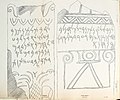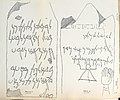The Hadrumetum Punic inscriptions are Punic votive inscriptions found in the Old City of Sousse (ancient Hadrumetum).
They were discovered between the Great Mosque of Sousse and the Ribat of Sousse, where the French authorities had chosen to build Sousse's first church, the Église Notre-Dame-de-l'Immaculée-Conception de Sousse, built between 1865 and 1867. After WWII war damage was repaired, the church was later demolished by the local authorities as part of a renovation of the Old City.
The first nine inscriptions were published by Julius Euting in 1872. Further inscriptions were found in 1946 after World War II bomb damage exposed more of the area around the church.
The inscriptions are held between the Sousse Archaeological Museum, the Louvre and the Maison méditerranéenne des Sciences de l'homme.
Euting inscriptions
Euting bought the steles from Maltese masons at La Goulette (Tunis), who discovered them in 1867 during foundation work for a church in Sousse 7 meters underground. The church was the Église Notre-Dame-de-l'Immaculée-Conception de Sousse, built between 1865 and 1867 by the French authorities as the first church in Sousse. After war damage was repaired, it was later demolished by the local authorities as part of a renovation of the Old City of Sousse.
Gallery
-
 Hadrumet 1 and 2
Hadrumet 1 and 2
-
 Hadrumet 3 and 4
Hadrumet 3 and 4
-
 Hadrumet 5 and 6
Hadrumet 5 and 6
-
 Hadrumet 7 (KAI 97 and Lidz NE 432,1) and 8 (Lidz NE 432,2)
Hadrumet 7 (KAI 97 and Lidz NE 432,1) and 8 (Lidz NE 432,2)
-
 Hadrumetina 9 (KAI 98 and Lidz NE 432,3)
Hadrumetina 9 (KAI 98 and Lidz NE 432,3)
Truillot inscriptions
In 1946, Alexis Truillot, curator of the Sousse Archaeological Museum, took advantage of the excavations carried out at the church, following the destruction in the war, to attempt a survey of the site. Nine further Punic stelae were found, including three with inscriptions.
Bibliography
- Euting, Julius (1871). Punische Steine. Mémoires de l'Académie Impériale des Sciences de St.-Pétersbourg (in German). Académie impériale des sciences de St.-Pétersbourg.
References
- Une pensée pour Si Ahmed Noureddine, Le Temps, 17 - 11 - 2012
- Punische Steine (1872)
- Cintas, Pierre (1947). "Le sanctuaire punique de Sousse". Revue africaine: Journal des travaux de la Société historique algérienne (in French). 91. Société historique algérienne: 1–82.
- Dussaud René. Review of Pierre Cintas, Le sanctuaire punique de Sousse. In: Syria. Tome 26 fascicule 3-4, 1949. pp. 387-388.
- Bénichou-Safar, Hélène (2010). "Les inscriptions puniques du sanctuaire de Sousse". Semitica et Classica (in French). 3. Brepols Publishers NV: 99–123. doi:10.1484/j.sec.1.100931. ISSN 2031-5937.
Ces inscriptions ont été collectées dans les rapports relatifs aux fouilles, dans deux fonds d'archives (Archives du Cabinet du Corpus à l'Académie des Inscriptions et Belles-Lettres de Paris et Fonds S. Lancel au Centre Camille Jullian à Aix-en-Provence / CNRS-Université de Provence) et dans deux musées (Musée archéologique de Sousse et Musée du Louvre à Paris).
- Punische Steine (1872): "Von den ersteren, den ineditis, sind einige in meinem eigenen Besitze befindlich, andere von wohlwollenden Freunden und Gönnern mir zur ersten Veröffentlichung überlassen. Von den in meinem Besitz befindlichen habe ich einen Theil bei meinem Aufenthalte in Carthago (October 1869) von arabischen Bauern in Mo'alqa, Mersa u. s. w. erworben, welche dieselben bei Feldarbeiten aus dem Boden der alten punischen Hauptstadt zu Tage förderten. Andere stammen aus dem Franziskaner-Kloster in der Goletta (der Hafenstadt von Tunis) und hat mir der Rev. P. Felix von Ferrara dieselben gütigst abgetreten. Derselbe versicherte, er habe die meisten derselben bei seinen Gängen auf die benachbarte, auf der Stelle der Byrsa erbauten Kapelle des heiligen Ludwig von Frankreich, der hier bekanntlich 1270 an der Pest verstarb, ohne weitere Nachforschungen entdeckt. Die mit «Hadr» bezeichneten habe ich von maltesischen Maurern (auch in der Goletta) gekauft, welche dieselben bei Gelegenheit der Fundamentirungsarbeiten für eine christliche Kirche 7 Meter unter der Bodenoberfläche zu Susa (dem alten Hadrumetum) im Jahr 1867 entdeckt hatten. Näheres über etwaige sonstige Reste eines phönik. Tempels oder dgl. konnte ich nicht in Erfahrung bringen. Zwei Steine, darunter einen mit einer Inschrift (C. 218) habe ich von Herrn K. Kallenberg, Kaufmann aus Lindau, erworben, der dieselben gleichfalls von Maurern in der Goletta gekauft hatte."
- Une pensée pour Si Ahmed Noureddine, Le Temps, 17 - 11 - 2012
- Dussaud René. Précisions épigraphiques sur les sacrifices puniques d'enfants In: Comptes rendus des séances de l'Académie des Inscriptions et Belles-Lettres, 90 année, N. 3, 1946. pp. 371-387. DOI : https://doi.org/10.3406/crai.1946.78010
External links
![]() Media related to Hadrumetum inscriptions at Wikimedia Commons
Media related to Hadrumetum inscriptions at Wikimedia Commons